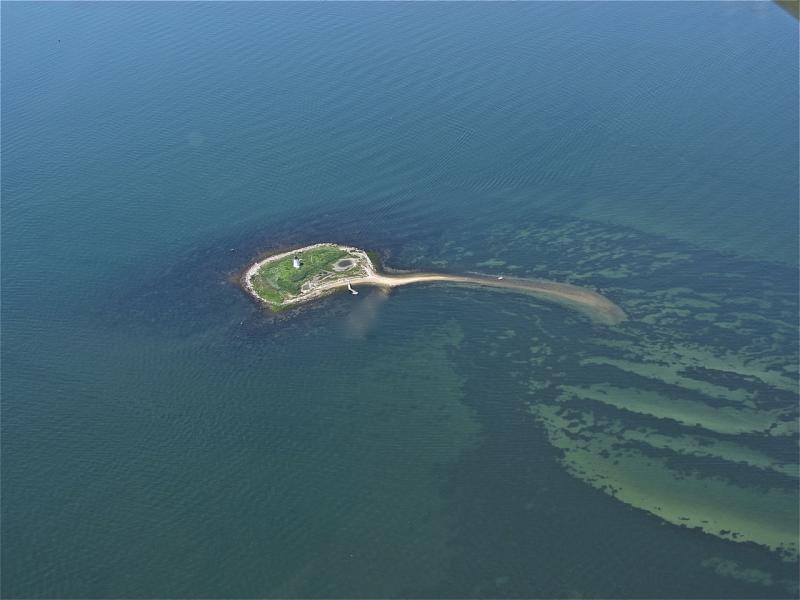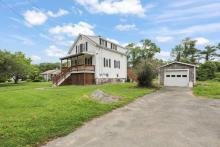Officials hopeful Bird Island restoration project ready to take off
Roughly four acres in size, Sippican Harbor’s Bird Island is small. However, its future has major consequences for the endangered roseate terns that nest there seasonally.
Heavy storms and rising seas have taken a toll on the birds’ habitat through the years. To combat the erosion, federal and state officials are optimistic money will soon be available to fund an estimated $4.2 million restoration effort on the island.
“We’re feeling confident,” said Carolyn Mostello of the Massachusetts Division of Fisheries and Wildlife. “It’s not one hundred percent guaranteed. One of our enemies here is the timeline… It’s a challenge but we’re working on all fronts.”
A migratory species, the terns land on the island starting in May and take flight in August when breeding season ends. The sandy, rocky outpost, which is home to historic Bird Island Light, supported 1,100 pairs of terns in 2014. That accounts for 30 percent of the North American population.
Mostello, a coastal waterbird biologist, said if state funds were approved work could begin this September.
Partnering with the state agency would be the U.S. Army Corps of Engineers and the town of Marion. Since 1966, Marion has owned the island, located less than a mile off the mainland.
Restoration planning started in 2001 when the Division of Fisheries and Wildlife hired consultants to research issues related to design, engineering and permitting.
The Army Corps of Engineers became involved in the following year when it conducted a restoration feasibility study.
After that the project languished.
“Between 2002 and 2011 things moved slowly, at glacial speed, but they were still moving,” Mostello said.
Last November, the Army Corps of Engineers learned it would get federal funds for the project in fiscal year 2015.
“So we started moving really fast,” Mostello said.
The U.S. Army Corps of Engineers Aquatic Ecosystem Restoration Program requires the federal agency to contribute 65 percent of the project’s cost. Under the program a local sponsor, in this case the Division of Fisheries and Wildlife, would pay the remaining 35 percent.
Plans call for rebuilding the island’s seawall, which would reduce habitat erosion from crashing waves. The seawall would also be heightened to nine and half feet. The tallest point on the island is 10 feet.
Adam Burnett, the Army Corps of Engineers' project manager, said plans were drafted after several models predicting rising sea levels were analyzed. The most aggressive model was used.
“The highest curve said there could be a two foot elevation gain in the next fifty years,” Burnett said. “If we decided that’s not going to happen and then it does, we’ve done a lot of effort to have to go back and rebuild.”
In addition to the seawall, native grasses would be planted on the island to support nesting terns and fortify the island against erosion.
Marion officials supported the project, though several questions were raised regarding the town’s continued use of the Bird Island.
Currently, the Conservation Commission manages the island. People may visit the island with permission from the harbormaster’s office. School children visit the island during field trips throughout the year.
For the restoration project to move forward voters at the upcoming Annual Town Meeting must grant an easement on the tern’s habitat to the Division of Fisheries and Wildlife. The agreement states that the site would be set aside for permanent conservation.
Under the easement, the town would still have lighthouse access for maintenance purposes. The Army Corps of Engineers has promised to construct a road that would help harbormaster employees maintain Bird Island Light.
“The project will benefit the terns, the lighthouse and the whole island,” said Harbormaster Michael Cormier.
Mostello agreed.
“The terns already restrict what happens on the island, that won’t change, and hopefully it will be easier for [Cormier] to work on the island with the road,” she said.
Selectmen thanked state and federal officials for their efforts at the end of their Tuesday meeting.
“For a small patch of ground it sure is a whole lot of work, but it shows you the complexity of what goes into maintaining this environment,” Chair Jon Henry said.















